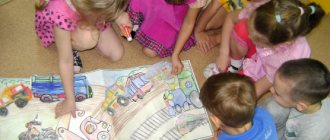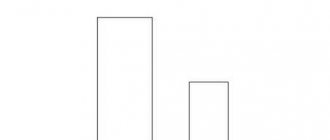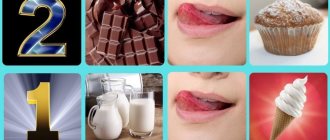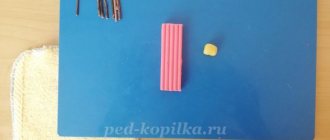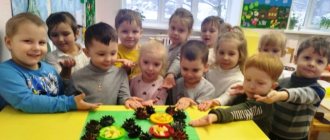Theme of the week: “Transport”
Lesson 13. Boat with oars
(Modeling from plasticine)
Program content. Continue learning how to roll out an oval from a ball, flatten it and press the middle with your fingers, tighten and trim the edges. Roll out the sausages, flatten them with your fingers on one edge and attach them to the molded product. Develop fine motor skills of fingers and attention.
Demonstration material. Pictures of airplane, car, train and boat.
Handout. Plasticine, blue cardboard stands, modeling boards.
Progress of the lesson
Place pictures of an airplane, car, train and boat in front of the children. Describe each item, and let the children guess what kind of toy we are talking about:
- It has four wheels. She drives on the roads and carries people. (Car.)
– It is very long and runs on rails. (Train.)
- He flies in the sky. Made of iron. There are two wings. (Airplane.)
– You can swim on it. It is made of wood. (Boat.)
Play the game "What's missing?" The children close their eyes and you remove one of the four pictures.
Offer to fashion a boat out of plasticine. To do this, you need to roll a large ball, roll it between your palms into an oval with back and forth movements, flatten and press the middle with your fingers, pull and trim the edges to make a neat boat. Make oars - roll out the sausages, flatten them with your fingers on one edge and attach them to the side edges of the boat. Place a stand on the cardboard.
Technological map for sculpting “Machines” in the senior group
Irina Getman
Technological map for sculpting “Machines” in the senior group
Educational field: Creativity.
Section: Modeling .
Topic: Cars .
Goal: the ability to convey the characteristic features of a car using plasticineography techniques .
— deepen and expand children’s knowledge about ground transport;
- learn to identify similar and different characteristics of cars and trucks - size , color, shape;
- learn to identify parts of cars - trunk , hood, body, wheels, steering wheel, etc.;
— develop the ability to paint over an image of a car with plasticine;
— continue to introduce children to the unconventional drawing technique “plasticineography”
— conversation about cars and trucks;
- examination of subject pictures “Cars”
;
— reading poems and riddles about cars;
— p/i “Sparrows and Cars”
— cars;
— illustrations depicting cars;
“ machine ” handout
- blank images of cars (for each child)
There's a knock on the door. Guys, someone came to visit us, I’ll go and have a look. Bunny comes in.
Say hello to the guys! What a beautiful bunny, fluffy and soft.
Bunny, what happened to you, who scared you so much?
Guys, when I was walking towards you, I saw something like that on the street, they were honking, running fast, fast, beeping (honking, I was so scared, what was it?
Educator: Children, what do you think scared our bunny so much?
Children: cars
Bunny, sit and listen, the children will tell you everything they know about cars .
There are toy cars .
Educator: Children, what do you see on the table? These are cars , how many are there?
Educator: This is a passenger car, it has wheels, windows, a steering wheel.
car is this ?
Educator: Do you know what this car is called ?
This is a truck , it has a body, windows, and a steering wheel. The truck can transport ,
various loads in your body (sand, bricks, furniture)
.
Can we transport cargo in a small car
Bunny, now you know what cars , what types of cars there are .
Guys, when the Bunny goes home, how can he cross the road? Are there cars driving ?
Let's play with our hands
And remember about transport (connect fingers with thumb)
Let's fly on an airplane
Clouds, how are you living? (Represents the wings of an airplane)
Rocking in a boat
And we smile at the waves (Palms in a boat shape)
, depict waves)
We accelerate the motorcycle,
We play races (Clench your fingers into a fist, relax)
With wind, sun and friends. (Hands in a tube - blowing like a breeze)
; hands up are the rays of the sun. Hands point to friends)
Call transport with us. (Press the pads of the fingers against each other on the corresponding hands)
Bunny, now the guys will show you how you can make small cars from plasticine .
But we will not only sculpt, but also decorate our cars . You say, but we don’t have paints.
How will we paint with plasticine?
Let's sit down at the tables and paint the cars in bright colors .
(The teacher hands out car )
Familiarity with the depicted subject. Selecting a machine .
Showing the sequence of actions and sculpting .
1. Apply blue plasticine to the drawing, carefully, without going beyond the outline.
2.Now we need to add elements: wheels – black, headlights – yellow. Children choose any colors themselves.
You guys are so great! It turned out very well! Our cars are painted .
Reproduce: how to sculpt a car;
They understand: what parts the car consists of;
Apply: the ability to paint over an image of a car with plasticine, using the unconventional technique “plasticineography”
.
Technological map “Letters from the Queen of Mathematics” Technological map of organized educational activities in the senior group Educational area: “Cognition”. Section: "FEMP". Letter subject.
Children's crafts - Modeling with design elements Here our train is moving, the wheels are knocking
Not long ago, my children (middle group) and I learned to create a collective composition from a train and trailers.
I showed the guys a method for dividing a block of plasticine in a stack into approximately equal parts (cars). They discovered the ability to combine plasticine with other materials (windows made of paper, a steam locomotive pipe made from a felt-tip pen cap, trailers connected by halves of a match). Developed a sense of form and proportion. They cultivated enthusiasm for reflecting their own memories of the outside world through plastic means in stucco crafts and compositions. Developed fine motor skills of the hands.
Materials used:
The guys couldn't stop looking at their own train
searchmasterclass.net
Exercises about transport
Exercises about transport
To drive a car, we need to inflate the tires (imitation of movement with the sound sh-sh-sh). We’ll pour gasoline into the gas tank (imitation of movement) And we’ll go to the store (“drive” around the room).
Airplane
We put our hands out: (Hands to the sides.) An airplane appeared. (They flew like airplanes.) Swing the wing back and forth, (Tilt left and right.) Do “one” and do “two.” (Turns left and right.) One and two, one and two! (Clap your hands.) Hold your arms to your sides, (Hands to your sides.) Look at each other. (Turns left and right.) One and two, one and two! (Jump in place.) Put your hands down, (Lower your hands.) And everyone sit down! (Sit down.)
Locomotive
The locomotive “Tu-tu” hummed (Children put their hands on the shoulders of the child standing in front) And the carriages drove away. Chu-chu-chu, chu-chu-chu (“steam locomotives” travel in a circle)
I'll rock them far. The locomotive shouts: “Doo-doo, I’m coming, I’m coming, I’m coming.” And the wheels are knocking, And the wheels are saying: “Well, well, well!” (Walking in place, moving forward. Move back and forth with bent arms)
***
Steam locomotive, steam locomotive Steam locomotive, steam locomotive Brand new, shiny. He brought the carriages, exactly the real thing. Who's on the train? Teddy bears, fluffy cats, hares and monkeys. Who's on the train? Dolls and nesting dolls, Switchman, switchman Came out of the gatehouse. Long, long, long road Along our room Right to the threshold. (When reciting a poem, children imitate the movement of a train.)
Train
We go, we go, we go for a long time, This path is very long. We'll get to Moscow soon, there we can rest. Here is our train, the wheels are knocking, and the guys are sitting on our train. Chu-chu-chu-chu-chu! The locomotive is running. He took the boys far, far away. (Walking on bent legs)
Motor ship
The ship pushed off from the green pier, (The children stood up.) One, two, He stepped back first (Step back.) One, two, And then stepped forward, (Step forward.) One, two, And swam, swam along the river, ( Wave-like movement of the arms.) Gaining full speed. (Walk in place.)
Bus
We got on the bus together (Children get on) And looked out the window. (look around) Our driver pressed the pedal, (“press” the pedal) And the bus ran. (run away)
Traffic light
One two three four five! Oh, we're tired of writing. (Stretching.) We will play “Traffic Light”, (Walking in place.) Stretch our arms and legs. (Shaking arms. Shaking legs.) Red light for us “Stop!” - shouts, orders to wait for green. So that the wait won't be boring, we bend down together. And back. And forward. (Tilts.)
Left, right turn. (Turns the torso.) Now the yellow light is on, it’s time to get ready. Let's warm up our arms and legs, (Jerks with arms in front of the chest.) Let's start, kids! (Walking in place.) We’ll lift it up, we’ll lower it down, we’ll fly like an airplane. (Jumping.) When the green light turns on, we can go forward. Left, right, Left, right, (Running with a high hip lift.) We boldly move forward. (Walking in place.) The traffic light is a glorious assistant. It doesn’t let us get tired.
Fizminutka about transport
We rode on a horse, (We walk in place.) We reached the corner. We got into the car, (Running in place.) We poured gasoline. We drove by car and reached the river. (Squats.) Trrr! Stop! U-turn. (Turn around.) There is a steamer on the river. (We clap our hands.) We rode by steamboat and reached the mountain. (We walk in place.) The ship is unlucky, we need to board the plane. The plane is flying, the engine is humming: (Hands to the sides, “fly.”)
-U-u-F.
Car
A car was walking down the street, A car was walking without gasoline, A car was walking without a driver, Without a traffic light signal, Walking without knowing where, Walking was a cranky car. (Move in a given direction, turning an imaginary steering wheel)
Fizkultminutka Motor ship
The ship pushed off from the green pier, (The children stood up.) One, two, He stepped back first (Step back.) One, two, And then stepped forward, (Step forward.) One, two, And swam, swam along the river, ( Wave-like movement of the arms.) Gaining full speed. (Walk in place.)
ucthat-v-skole.ru
Theme of the week: “Winter”
Lesson 14. Snowflake
(Plasticine molding)
Program content. Continue learning to roll sausages and construct the intended object from them in the form of a bas-relief (the image protrudes above the background plane). Improve the ability to understand and analyze the content of a poem. Develop fine motor skills of fingers, eye and imagination.
Handout. Circles made of blue cardboard with a diameter of approximately 12–15 cm according to the number of children, white plasticine, stacks.
Progress of the lesson
Read to the children an excerpt from K. Balmont’s poem:
Light fluffy
Snowflake is white.
How clean
How brave!
Ask the children:
-What snowflake is in the poem? (Bold, pure, white.)
– How else can you describe a snowflake? (Cold, prickly, shiny, etc.)
Offer to depict snowflakes. You need to roll several balls of the same size and roll them into thin sausages. Show the children how to make a snowflake using sausages intersecting in the center on round cardboard and decorate it with short sausages or in other ways.
Theme of the week: “New Year’s holiday”
Lesson 16. Green Christmas tree
(Modeling from plasticine)
Program content. Learn to convey the structure of a Christmas tree by connecting plasticine columns of different lengths together in a certain sequence. Practice using stacks. Develop the ability to switch attention.
Demonstration material. Subject picture of a Christmas tree.
Handout. Plasticine, cardboard stands, modeling boards.
Progress of the lesson
Read the poem by V. Bardadym to the children:
Christmas tree green,
Shaggy Christmas tree,
Let's play, Christmas tree,
With our guys.
Children stand in a circle, holding hands. Ask them to show what kind of Christmas trees grow in the forest:
“Wide,” the children take a few steps back, expanding the circle.
“Thin,” the children approach the center of the circle, narrowing the circle.
“Tall,” everyone raises their hands up together.
“Low,” they squat and lower their arms. Look at the subject picture of the Christmas tree and determine what
it has a trunk and branches with needles. Offer to make a Christmas tree. To make a barrel from brown plasticine, you need to roll a ball, roll it into a cylinder, narrowing one side by rolling with pressure between your palms. Roll small green balls into sausages and cut them in stacks into short, medium and long pieces. Explain that short sausages need to be attached to the top of the trunk on several sides, medium-length sausages a little lower, and long ones at the very bottom. The resulting Christmas tree can be mounted on a cardboard stand, having previously decorated the stand with white plasticine (snow).
